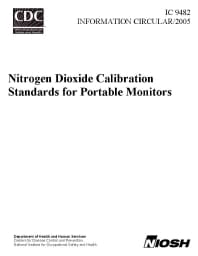Mining Publication: Nitrogen Dioxide Calibration Standards for Portable Monitors
Original creation date: December 2005
Authors: JE Chilton, RJ Timko, EJ Chuhta
NIOSHTIC2 Number: 20028929
U.S. Department of Health and Human Services, Public Health Service, Centers for Disease Control and Prevention, National Institute for Occupational Safety and Health, DHHS (NIOSH) Publication No. 2006-104, Information Circular 9482, 2005 Dec; :1-14
Mine operators and Mine Safety and Health Administration inspectors use portable gas monitors in underground mines to measure worker exposure to various gases such as methane, carbon monoxide, and nitrogen dioxide (NO2). Even in relatively small concentrations, NO2 can produce harmful side effects in underground workers. Mines using equipment powered by diesel engines, carrying out explosive blasting operations, and performing extensive arc welding and/or cutting work will have measurable quantities of NO2 released by these processes. Workers in these areas often use gas monitors to warn of excessive gas concentrations and to help them determine when to increase ventilation air that will dilute these gases, thus minimizing exposures to this gas. Portable gas monitors, used to measure NO2 levels, must be calibrated before each use. Calibration is typically performed using a small portable pressurized cylinder containing a certified gas mixture. The certified NO2 standard mixture, usually 10 ppm NO2 concentration, is diluted with either air or nitrogen gas. To determine the stability of commercially available portable gas standards, two different cylinders containing NO2 in nominal 10-ppm concentrations were examined. One cylinder was diluted in air, the other, in nitrogen. Baseline NO2 mixtures were generated using a standard liquid NO2 permeation tube operated at a constant temperature. Final dilutions of the test gas mixtures were made with air or with nitrogen using a mass flow-controlled gas dilution system. This study showed that, when a permeation-type NO2 generator is used, the electrochemical sensors in portable NO2 monitors provide identical results for gas mixtures whether they are diluted with air or with nitrogen. Two different gas monitors, one with a two-electrode sensor and one with a three-electrode sensor, were used to measure gas concentrations in the two commercially available cylinders. One month after the cylinders were delivered, the NO2-in-nitrogen cylinder, stated to contain 10 ppm NO2, measured 8.13 ppm. The NO2-in-air cylinder, also stated to hold 10 ppm NO2, measured 6.88 ppm. Therefore, before using NO2 gas cylinders to calibrate monitors, it is recommended that their concentrations be verified either by manufacturer recertification or by comparing the stated cylinder gas concentrations to a laboratory-based permeation tube-generated standard.

NIOSHTIC2 Number: 20028929
U.S. Department of Health and Human Services, Public Health Service, Centers for Disease Control and Prevention, National Institute for Occupational Safety and Health, DHHS (NIOSH) Publication No. 2006-104, Information Circular 9482, 2005 Dec; :1-14